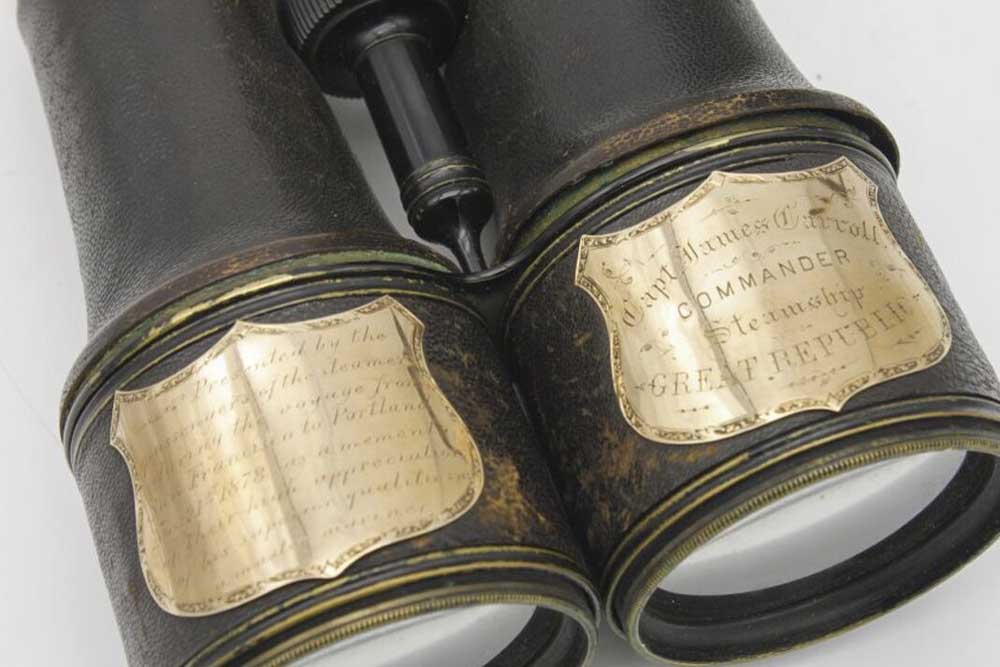Weekend Break: An ‘apogee’ steamship
Published 1:00 pm Friday, April 5, 2024

- Capt. James Carroll was given a set of binoculars as a gift of thanks for his “superior qualities as a master mariner.”
When it was built, the Great Republic was intended to be a symbol of the United States’ unity after the Civil War. President Lincoln signed on to the construction of four Pacific Mail Steamship Co. steamships just two months before he was assassinated.
Trending
Throughout the mid-1800s, Japan and China became important trade partners with the U.S. and substantially grew the West Coast’s economy.
In February 1865, Congress passed an act to authorize the establishment of an ocean steamship service between the United States and China to expedite foreign trade. With more trans-Pacific engagement, the U.S. would build its way toward becoming a dominating world power.
At 360 feet long and 48.5 feet wide, Great Republic was once the largest passenger ship on the West Coast. The two paddle wheels propelling the ship were 40 feet in diameter.
Trending
Construction of the ship cost about $1 million, which was unheard of in the 19th century. Historian Andrew P. Roberts writes, “Great Republic … was considered the apogee of wooden steamship technology … The ship married a massive structure and solid features with elegance and luxury rarely seen in steamships.”
Many immigrants from Asia came to the U.S. during the 19th century to work in burgeoning industries that many white Americans were unwilling to take up, including railroading and cannery work.
While first-class and second-class cabins were typically reserved for white European and American passengers, many steerage passengers were Asian. Between 1867 and 1877, the Great Republic carried about 10% of Asian immigrants who arrived in the U.S. over the course of 25 voyages.
On April 19, 1879, the Great Republic attempted to enter the mouth of the Columbia River. The ship had left San Francisco on April 16 and was carrying about 900 passengers at the time it wrecked.
Bar pilot Thomas Doig boarded the vessel to assist Capt. James Carroll in navigating the notoriously treacherous area.
It was a calm day and the weather was good for crossing, but unfortunately, Doig miscalculated how close Great Republic was to Sand Island on the Washington state side of the river.
Despite Carroll’s concerns, they forged ahead and the ship glided into the sand.
The accident took place at high tide, which meant it would be nearly impossible to refloat the ship as the tide changed. Sand filled its bilge pumps and water began pouring onboard.
Carroll’s primary concern was getting all the passengers safely off the ship. The steam tugs Brenham and Canby and steamers Shubrick and Columbia assisted in moving passengers from the lifeboats to safety in Astoria.
All 886 passengers survived the wreck, but the last rescue boat with 14 crewmen was hit by a massive wave and capsized. Eleven of the 14 people aboard drowned.
While both Doig and Carroll had their licenses suspended after the shipwreck, Carroll’s was immediately reversed after an appeal. His crew and passengers rushed to his defense as he worked to clear his name.
Carroll went on to have a prolific career in the maritime industry, working into the early 20th century.
He received a set of binoculars from his passengers onboard a steamer from San Francisco to Portland as a gift of thanks for “his superior qualities as a master mariner.” This artifact is now a part of the Columbia River Maritime Museum’s collection.









